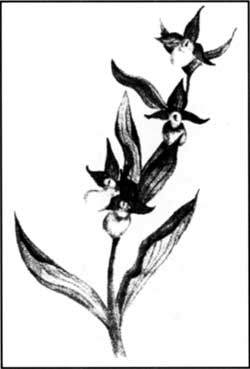Other factors promoting diversity
A lack of nutrients and water (up to a point) encourage greater diversity because plants then spend more of their energy surviving such conditions rather than competing with other plants and causing them to become extinct. The leaching of soil nutrients through high temperatures and rainfall lowers the productivity of soils and may increase the diversity of herb. Since the KSE is characterized by low rainfall during the growing season for herbs, habitat diversity is heightened because there are marked differences in slope and aspect that control evapotranspiration and the water retention capacity of soils.
More nutrients and water allow certain plants to dominate and thus reduce plant diversity, the so-called paradox of enrichment. The KSE is an area of climatic extremes, with annual rainfall amounts ranging from 100 inches near the ocean to 15 inches further inland. The differences in rainfall gives rise to a patchy distribution of plants, with the many subspecies and varieties of certain plants indicate rapid speciation—especially in their adaptation to dry soils of serpentine, marble, and granite. For example, dwarf ocean spray, myrtle, buckthorn, and tanoak stay small in stature even if grown in gardens with lots of water. Drought adaptations in endemic plant species include large tubers (as in lillies and toothworts), woodiness (as in pussytoes and pincushion), and waxy, hairy or divided leaves. Storing carbon dioxide at night so that water is not lost through leaf pores by day has favored many endemic sedums and lewisias.
The varied habitats and climate change over thousands or millions of years resulted in 50 or more disjunct species, plants whose brothers or population centers are hundreds of miles distant. Mutations are favored in such situations because of their small populations and the need for new adaptations to survive in a less than ideal habitat. The KSE also hosts at least 100 plant species at the edge of their range, where speciation most likely occurs due to isolated populations undergoing rapid change. Being at the right location between northern and southern plant communities, the KSE is situated so as to have a high number of disjunct species as well as plants at their geographic limit.
As a refuge for plants that once ranged from Japan to Georgia, the KSE provides rare habitat in the western United States. Many of the plant relicts are members of old families: heathers, orchids, honeysuckles, birthworts, and lillies. Plants such as fairybells, woodland stars, dogwoods, rhododendrons, redwoods, trilliums, gaultheria, and coralroots have their greatest diversity of species in the northwest and southeast United States, as well as in eastern Asia. Paleoendemics evolved once tectonic forces and climate changes cut the connections to other landmasses. Trees such as Port Orford-cedar and Baker cypress, for example, have “twin” species in Asia. Likewise, cousins of plants in the KSE such as vanilla leaf, tanoak, Oregon grape, redwood, and skunk cabbage grow in eastern Asia.
Conclusion
 California Lady Slipper. Drawing by Heather McDonald. |
The KSE enjoys the best of diversity among plants; it contains older flat areas where the lack of major disturbances has allowed paleoendemics to survive, but also provides newer habitats like cliffs and cirque lakes where new species can evolve due to isolation and a lack of competition. Northern Florida may possess more paleoendemics and Hawaii has greater numbers of neoendemics than the KSE. Parts of Nevada and Arizona display more edaphic endemics, but the distinctiveness of the KSE lies in its mix of all three types of endemic plants—more profuse than anywhere north of Mexico. In few other places will the location, size, varying ages and geodiversity of mountains with their varied climates combine to produce so many relicts, disjuncts, endemics, varieties, hybrids, and plants near their geographic limit. The Illinois Valley is a botanist’s delight each spring, while Oregon Caves constitutes a representative slice of the fascinating floral diversity found throughout the KSE.
Note
1The monument list contains some 400 plant species in only 480 acres, whereas Crater Lake National Park boasts fewer than 700 in 183,220 acres.
John Roth became fascinated with the plants of southwestern Oregon upon arriving at Oregon Caves National Monument in 1988.

